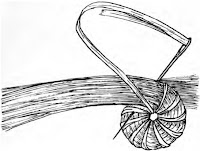Twining is the earliest known method of weaving. This technique involves two or more weavers or wefts are twined around a warp (over and under) and not necessarily twisted. This technique is also called pairing of two weavers and wailing when three or more weavers are used. The diagram shows the technique starting on the left working over the warps to the right, a traditional Haida technique.
Twill is also referred to as the checkerboard weave or Salish weave. Where warps and wefts when woven together form a checkerboard pattern. The technique also allows for variation in that the weft can be woven over two warps or more, for patterns and designs, and not restricted to the single over and under checkerboard design. Warps can be envisioned as the skeleton of a basket and the weft or weaver as the skin.
In coiling, a bundle of strands or a twisted strand is stitched together into a spiraling, round or oval form with a thin, flexible weaver. It is a simple straight forward technique, that makes a firm and rigid basket in a relatively short period of time. There are several different types of coiling, including wrapping and the use of braids.


